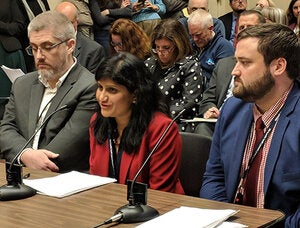
With a lack of federal action to set enforceable PFAS regulations, many states have taken it upon themselves to set safety standards for their citizens. For the last two years, health and environmental groups have been urging Rhode Island to do the same, but the state’s Department of Health (DOH) and Department of Environmental Management (DEM) declined to do so as they were still conducting research and testing within the state and waiting for national guidance.
However, the Ocean State may be finally ready to set regulations. At a February 6th Statehouse hearing, DOH’s chief of environmental health, Seema Dixit, stated that a draft of PFAS regulations will be released by May of 2020. “We are now at a juncture of finalizing all of our analysis through sampling efforts to have a clear picture of the PFAS exposure in the state,” Dixit said. Although she didn’t offer specific details on regulations, other DOH members indicted that a threshold of 20 parts per trillion (ppt) was being studied. The US Environmental Protection Agency has established a health advisory of 70 ppt in drinking water for two of the most common PFAS chemicals (PFOA and PFOS).
In 2019, DOH tested every major drinking water supply, and found that 44 percent of water systems had detectable PFAS levels. One water system had levels greater than 70 ppt, and 13 water systems had levels greater than 20 ppt.
The Statehouse hearing was held to discuss two bills proposed by the Rhode Island House of Representatives—to ban PFAS in food packaging and to regulate PFAS in drinking, ground, and surface waters. Several stakeholders attended the hearing, including The American Chemistry Council, which opposed both bills. DOH and DEM support the food packaging bill, but are waiting to set their own regulations before supporting the drinking water bill.
If the PFAS drinking water bill passes, it would require testing and treatment for PFAS in all water treatment facilities if levels exceed 20 ppt. It also requires monitoring of the liquid effluent, called leachate, from landfills, in order to prevent ground water contamination.

